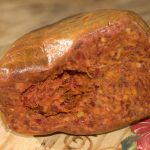
Nduja which is pronounced as ‘in-do-jah’ is a rather spicy sausage from the region of Calabria which sits at the toe of Italy looking across to Sicily. Rather like Ferdinand, Duke of Calabria in the play Duchess of Malfi, it seems to have quite a fiery temper which at any moment might burst itself with its own flavour. From my perspective it is really a soft, coarse pate or a spreadable salami (Amazon’s term) which is reminiscent of that Mallorcan delicacy sobrassada. As an ingredient for any sort of Italian dish, it is certainly something worth pursuing for its glorious heat but unctuous flavour.
Don’t baulk at the ingredients because it resembles a haggis and sobrassada with the use of various pig head pieces and plenty of fat to boot. A typical nduja will contain at least 40 per cent pork fat with the remainder being meat, hot red chilli and some salt and black pepper. I always liken it to the way my Grandma used to make brawn but without the really delicious pig cheeks. The cheeks are made into guanciale which is an important ingredient in its own right replacing pancetta in pasta dishes. That also means the meat will be head but also other pig parts including shoulder, lung, liver and belly as well. This is all about umami or even kokumi. Make sure you can stand chilli because this red pepper gets quite an outing creating one of the host sausages.
The name Nduja derives apparently from the French word andouille. This particular French sausage salami is a tripe. The food is stuffed into the lower large intestine of the animal too just to add to the effect. This is left for fifteen days to ripen off and bring out the sensuous flavours. It is worth noting that the sausage can also be truly aged for a very long time – like a year. The sausage is stored in an open but cool area with no ‘smoking’. It might be stored for two years whilst all those flavours meld together.
Nduja really is much older though than the French name. It began life with the Ancient Greeks colonising the Ionian islands and coastline. The modern version is probably from the late 18th century when the French and Italians fought the Spanish. It is regarded as a poor man’s product because of what it uses but in reality it is typical of all those foods where nothing goes to waste. Spilinga seems to be the Italian town where it is most closely associated. The peppers used then were pepperoncinos but all sorts of chillis have been tried out including the really hot Scotch Bonnet. Given that hogs are such as issue in the USA, it might be a suitable product for all those feral pigs that roam the countryside.
Very few of us will have tasted the product unless dining out in one of those Calabrian towns but then Waitrose began offering it as a spread. Rather like andouillette it has generated a following for all those looking for something truly authentic in flavour to offer southern Italian cooking. If you have it as a sausage then it is versatile enough to be grilled and cooked as with sauces but it can also be consumed raw. The Barilla website also claims the sausage is called orba which is the name of the casing.
It works well with pastas especially the long stringy types like spaghetti. Frankly, it goes like pate on bread, ciabatta or biscuits which have a slightly stale note to them because it certainly overpowers them through flavour alone. Apparently, seafood and crabs in particular might be a good friend to this sausage. It also works itself into stews and casseroles, and to accompany pork chops. A few folk have worked it into baked potatoes, into a companionship with eggs, both poached or fried, into chips and as a pep up of squash. There are recipes for it serving as part of a topping on pizzas so just think about what else can be added.
We devised a Nduja sauce combined with tomato and red pepper which is ideal for coating various forms of pastas as well as providing additional punch to ravioli or tortellini. It could also serve as a general base for gnocchi as well just to really provide a spicy kick. Why not try it out.
Products based On Nduja
Please note this post contains links to our affiliate marketing partner. Please read the affiliate disclosure.


Leave a Reply